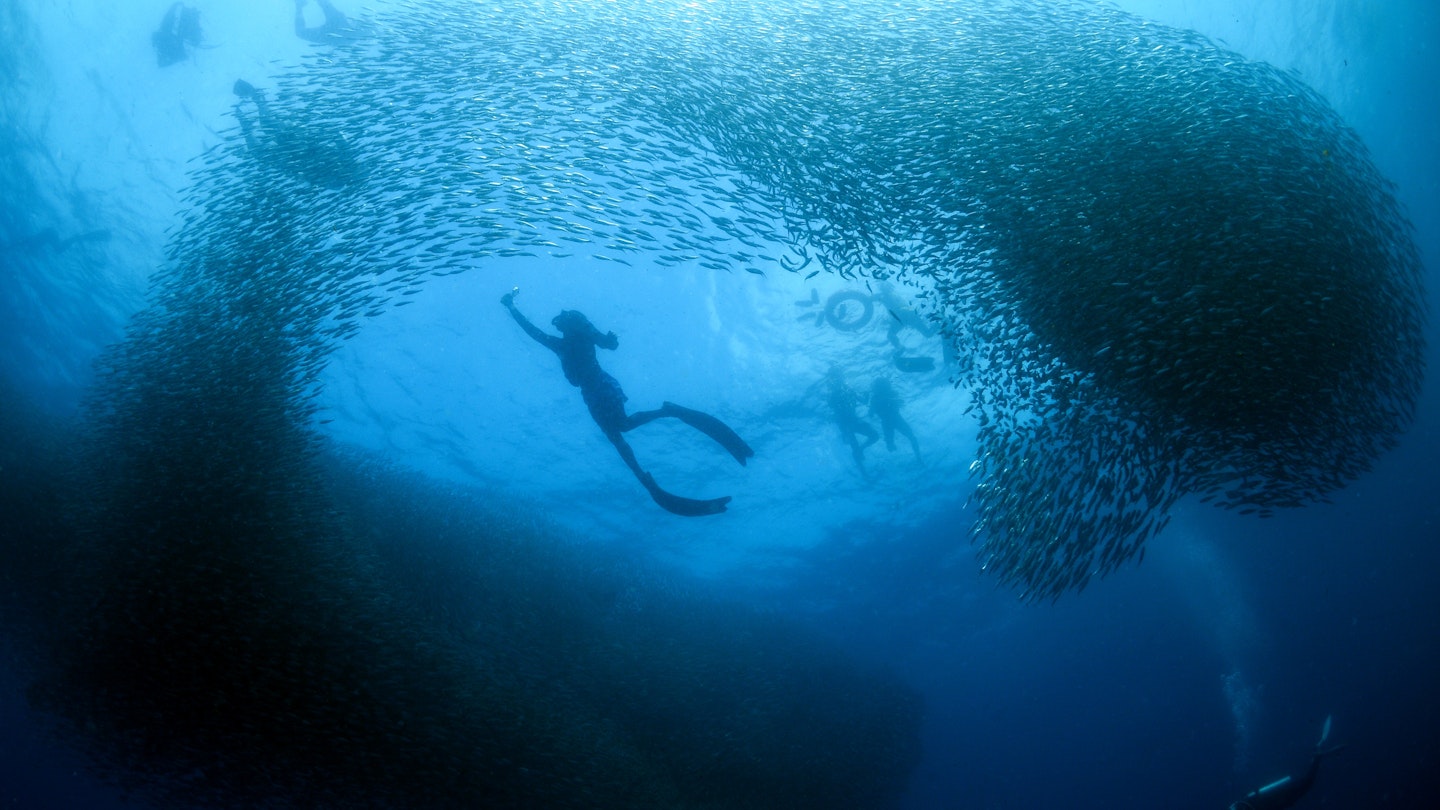Ever fancied donning your fins and swimming with millions of fish? I discovered a teeming tropical reef only metres from the beach in Moalboal, the Philippines, where I immersed myself in a hypnotic spectacle of seemingly infinite flashing silver sardines. The sardine run is a once-in-a-lifetime experience. If you’re keen to act like Ariel for a day, read on to find out how.
Why Go to Moalboal, Cebu?
Picture this: jungle-clad pathways giving way to a stretch of white sand and a smattering of beachside bars looking out over turquoise waters. Yes, Moalboal really is this idyllic.
With a multitude of islands to pique your interest (over 7,000), basing yourself in the Philippines can be as overwhelming as it is enticing. If, like for me, majestic marine life is your passion, the region of Cebu is your go-to hub. Boasting myriad diving and snorkelling sites—from swimming with polka-dotted whale sharks to exploring enigmatic wrecks—the islands here are synonymous with underwater sanctuaries.
Cebu Island is the region’s heart—a favoured jumping-off point to its surrounding isles. Before setting sail, I made a beeline to Moalboal on the island’s western shores. After a sweaty and slightly convoluted local bus route from Cebu City, I was raring to get into the water.
What is the Sardine Run?
Over a decade ago, Cebu’s sardine run was reportedly non-existent, and their sudden appearance at Panagsama Beach is a mystery. Regardless, the Moalboal community has welcomed the effect their fishy friends have had in the area. No mass fishing is permitted, but local fishermen can use small wooden boats with just a hook and line, and the sardines have encouraged more people to visit the area each year.
The annual sardine migration along the east coast of South Africa might be more recognized, but coming to Moalboal is notably different. Development and tourism remain relatively slow, so during my visit in April, I was one of a handful of people diving the reef.
Why Would I Want to Swim with Sardines?
So sardines aren’t your quintessential tropical fish. These scaly creatures are more likely to conjure up images of fish markets or squeezing onto your commuter train. Instead, envisage luminescent, ethereal figures swirling beside you, against a deep blue backdrop.
For the entire hour I was scuba diving with them, the fish looped in mesmerizing undulating formations. The shoals of sardines move through the ocean like flocks of starlings, often creating spherical shapes known as bait balls to trick their predators. Additionally, they rise close to the ocean’s surface to stay warm and to feed on plankton.

Snorkelling or Scuba Diving?
Whether you’re a dexterous deep-sea specialist, a budding freediver, or a mellow snorkelling enthusiast, the sardine run is suited to all aquatic abilities. Much of Moalboal’s appeal to ocean explorers is the reef’s ease and accessibility. The tide is usually calm with a lack of current, and the weather conditions are steady in the right season (November to April).
If snorkelling is your preferred method, you’re in luck. You don’t need a boat—because of the proximity of the reef to the shore and the sardines swimming close to the surface, you can simply wade out. If you have your own equipment, it’s totally free! Alternatively, you can hire a mask and snorkel from a beach bar or shop, as there are plenty to choose from.
However, there are benefits to scuba diving the reef. It was soothing drifting along the current and getting closer to the shoals—as visibility is better underwater. Diving allowed me to navigate and explore 12m of the 70m-deep reef’s plunge; there’s plenty more than sardines to see. Life on the reef itself is bountiful; adorned by colourful corals, I witnessed breathtakingly diverse shapes and hues in marine life such as floating nudibranchs, solitary squid, and cobalt-blue starfish.

When to Go
There’s no need to wait patiently for hours on end or hire a guide to witness this wildlife spectacular. The run is easy to locate by the reef drop-off and can pride itself on being an almost permanent feature—you can find the sardines here almost every day of the year. Just ensure you avoid the rainy season (from June to October) when planning your visit. My experience in April was balmy, with great visibility and warm waters.
Local Life
After a day’s watery antics, I whiled away the languid evenings of Panagsama at beach bars and eateries, often with a cool glass of Red Horse beer in hand. I savored a variety of Filipino dishes, from creamy adobo curries over steaming rice to pungent pots of sizzling salted prawns.
A range of guesthouses and hotels sit a stone’s throw away from the beach. I stayed at Mayas Native Garden, an intimate, rustic hideaway with five well-sized native nipa huts surrounded by gorgeous wild gardens.

Where to Next?
Further inland, Kawasan Falls is just a 45-minute drive away from Moalboal. The colour of the water is as vibrant as it looks in pictures and I spent an afternoon happily bathing in the waterfall’s pool.
If you’re seeking some earthly grounding after your aquatic pursuits, head to fun-loving Bohol for zip-lines and hiking thrills. A visit to this interesting isle wouldn’t be complete without meeting the world’s smallest primate in the Philippine Tarsier Sanctuary—as big-eyed and adorable as you’d imagine.
Pining for some relaxation? The Camotes Islands are remote and quiet. I was wowed by Mangodlong Paradise Beach Resort’s affordable luxury, where I topped off the trip with afternoon massages and basking on their private beach that I managed to have all to myself!





